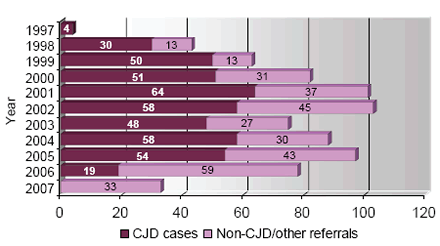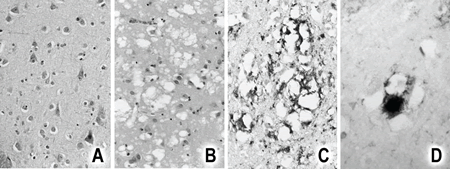Common menu bar links
Institutional links
Diseases & Conditions
Health & Safety
Research & Statistics
Agency Information
Search Box
E-mail this page
Creutzfeldt-Jakob Disease
Quick Links
CJD-Surveillance System
| Newsletters to Families | Newsletters to Physicians |
May 2007
PDF version ![]() (284 KB)
(284 KB)
[How to download PDF documents]
BULLETIN CJD, in addition to all other prion diseases, is provincially reportable in Canada. Physicians must report these diseases to local health authorities, as mandated by provincial legislation. |
|
May 2007 Highlights |
CJD-SS Progress Report
Established by Health Canada in 1998 as a national surveillance system for Creutzfeldt-Jakob disease, CJD-SS maintains ongoing surveillance for CJD under the recently formed Public Health Agency of Canada (PHAC). As of April 1 2007, CJD-SS reported 767 patient referrals including 316 cases of definite and probable CJD, confirmed by pathology or diagnosed on a clinical basis. Autopsy-confirmed cases represented 80.4% of our total CJD cases, ranking among the highest worldwide.
CJD-SS applies criteria set by the World Health Organization (WHO) when assigning a possible, probable or definite diagnosis of CJD. As reflected in graph A, case reports to the system have been relatively steady. This is likely attributable to sustained awareness of the disease, continual reporting by physicians, and the availability of 14-3-3 testing provided by the Surveillance System. Over 1016 CSF specimens have been processed since we began 14-3-3 protein testing in our laboratory in 1998. Through genetic analysis on 52% of patient referrals, CJD-SS has also facilitated the diagnosis of 20 cases of genetic prion disease including 11 cases of Gerstmann-Sträussler-Scheinker syndrome (GSS).
Graph A: Cases & Referrals to CJD-SS by Year of Reporting

Note: 2005, 2006 and 2007 figures are provisional.
For CJD incidence by year of death, please refer to our website.
In addition to laboratory testing, CJD-SS positions field investigators across Canada to complete risk assessment questionnaires by visiting the families of affected individuals. These field investigators also collect diagnostic data by conducting comprehensive medical chart reviews.
From 1999 to 2005, the years for which we have the most complete data thus far, the average incidence of definite/probable CJD is approximately 1.10 per million per year. This rate is consistent with international incidence rates1 of 1 case/million within the population. The success of CJD-SS surveillance activities is largely credited to ongoing support and cooperation from physicians caring for patients with CJD, and those families affected by this disease.
CJD-SS will continue to use active surveillance methods to identify and investigate all suspected cases in Canada, and assist physicians in diagnosing patients with symptoms of possible or probable CJD. We anticipate notification of future cases primarily through neurologists, pathologists, geriatricians, infectious disease specialists, and infection control practitioners. However, we ask any physician aware of a suspected case of CJD to please contact the Surveillance System using our toll-free number: 1-888-489-2999.
1. Ladogna A et al. Mortality of Creutzfeldt-Jakob disease and related disorders in Europe, Australia and Canada. Neurology 2005 May 10; 64 (9) 1586-1591.
CJD in a Recipient of Tutoplast Dura
Tutoplast Dura is a commercially processed dura mater obtained from human donors and manufactured in Germany. Regulated as a medical device, it was available in Canada between 1982 and 2002 for use in various surgical treatments.
In 2003, as previously reported by various sources, a case of classic CJD was confirmed by autopsy in a patient over the age of 55, who had received a Tutoplast Dura graft in 1992 during neurosurgery. This is the first reported case of CJD allegedly associated with Tutoplast Dura in Canada, although it has not been proven that the patient acquired the disease from the graft. Worldwide, there has been only one previous documented case associated with this particular brand of human dura mater where the graft was considered the most likely source of CJD in the patient1.
In April 2002, Health Canada suspended the licence for Tutoplast Dura and monitored a recall of the product. Prior to this action, Tutoplast Dura was the only human cadaveric dura mater product licensed for sale in Canada.
Physicians should be aware of the possibility of CJD in recipients of dura mater grafts who develop neurological signs and symptoms. The incubation period can be up to 20 years or more. They are advised to report any suspected cases of CJD in recipients of dura mater grafts to the CJD Surveillance System
Reference:
1. Hannah EL, Belay ED, Gambetti P, et al. Creutzfeldt-Jakob
disease after receipt of a previously unimplicated brand of dura
mater graft. Neurology 2001;56:1080-1083.
The Role of Human Genetics in Canadian CJD Surveillance
Surveillance efforts have repeatedly shown that approximately 10% of human prion diseases are associated with a rare mutation (genetic abnormality) in the DNA sequence of the PRNP gene. Over 30 different kinds of PRNP mutations have been observed in various affected patients.
The effects of PRNP mutations vary from a disease closely resembling classical sporadic CJD, to distinctive diseases such as, Gerstmann-Sträussler-Scheinker (GSS) and fatal familial insomnia (FFI). Discovery of a mutation by DNA analysis provides the single strongest reason for a diagnosis of inherited prion disease in the living patient.
However, final diagnosis of prion disease is still reliant on thorough examination of the brain tissues after death. In addition to disease-causing mutations, a commonly occurring variation at position 129 in PRNP, has an important influence in non-genetic forms of prion disease (both infectious and sporadic), but does not by itself cause disease. The same DNA analysis that is used to look for mutations also gives information on position 129.
For each suspected CJD patient for whom informed consent is given, the CJD-SS has provided laboratory services to completely analyze the portion of the PRNP gene where mutations occur. In this way, the presence or absence, and nature of mutations can be confirmed or disconfirmed, and information on position 129, are obtained simultaneously. More information on how to draw on these services as well as supporting technical information can be obtained by contacting the CJD Surveillance System.
Pathological Examination in CJD
Although a diagnosis of Creutzfeldt-Jakob disease (CJD) can be made quite likely by the neurologist on the basis of symptoms that the patient has and specific tests such as the EEG, examination of brain tissue at autopsy under the microscope is the golden standard for diagnosis of CJD. The pathologist generally finds in nerve cell containing areas of the brain of patients with CJD loss of nerve cells, microscopically small holes (also known as vacuoles, see fig B, compare to A which is normal), and gliosis, which is the accumulation of brain support cells. Further in special stains of the tissue the accumulation of the altered prion protein is seen as dark material (fig C).

This sort of examination allows variant CJD, which is associated with mad cow disease, and some of the inherited forms of CJD to be separated from this general picture, because of special features, like the florid plaque in variant CJD (a round accumulation of again dark staining prion protein surrounded by a ring of vacuoles seen in fig D). Thus the autopsy remains an invaluable instrument for the detection of CJD beyond any doubt, but also for identifying the exact subtype of CJD, even though it occurs only after death.
Reference:
- Hannah EL, Belay ED, Gambetti P, et al. Creutzfeldt-Jakob disease after receipt of a previously unimplicated brand of dura mater graft. Neurology 2001;56:1080-1083.
